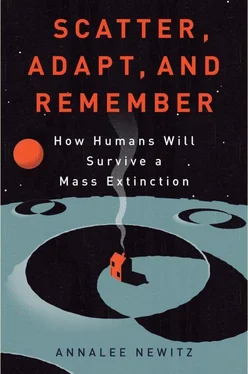Assuming we do make it through the intelligence explosion intact, however, Bostrom and his colleagues have a few ideas about what might happen to humanity. Most important to their scenarios is the idea of “uploading,” or turning our brains into software on computers. Our minds could be transferred into virtual worlds, where we would have incredible adventures and expand our consciousness to include the whole of human knowledge. When our bodies died, our uploaded minds would live on—and maybe get downloaded into new bodies. We could also make many virtual copies of ourselves, which is a particularly weird idea that would make perfect sense in a world where you could upload your brain anytime you wanted. Why not save yourself as an upload at different times, the way you do with avatars in a video game, so that you could revert to an older copy if something horrible happened that you’d rather forget? Uploads would completely change our relationships to our bodies and identities, as we easily slid between virtual and biological existence.
Because Bostrom believes this future of superintelligence and uploads is inevitable, he’s convinced that we won’t go to space at all. We won’t want to. Instead, we’ll convert all of outer space into a giant computer running all our uploads in a vast virtual world. His idea hinges on the notion that nobody would want to live in reality anymore when they could upload themselves into a virtual world of plenitude and mental transcendence. So instead of exploring outer space in fantastical vessels, we’d use robots to dismantle every object in space, from planets and asteroids to suns and black holes. Then we’d convert these massive bodies’ every molecule into a giant supercomputer where our uploaded brains could expand forever. In essence, we’d use our superintelligence to convert all of outer space into a vast virtual space for our minds.
What would this look like? Bostrom said, “There’s an image I have in my mind of … a growing sphere, a bubble of technological infrastructure with Earth at the center. It’s growing in all directions at the speed of light.” This growing sphere would be a machine that was converting all matter in the universe into what Bostrom calls “computational substrates,” or computers powerful enough to run a simulation that would satisfy machine superintelligences. In a sense, it would be like paving over the universe with our computers. “Most likely, everybody would live in virtual reality, or some abstract reality,” Bostrom concluded. Space would be ours, but only because we converted every piece of matter into our high-tech brain farm.
But, to continue the paving analogy for a moment, what if there was life using some of that matter in the universe? Wouldn’t we be destroying it to build our virtual world? Bostrom is unperturbed by this possibility. “My guess is that our observable universe doesn’t contain intelligence, so we don’t need to worry about taking matter away from them.” His main concern is what’s going on inside that sphere of technology he imagined hurtling out of the Earth. What if it were a version of the Windows operating system, but with superintelligence? In a dark scenario, “we might all be paperclips or calculating pi to millions of decimals,” he mused. But in a brighter one, we might be liberated from our bodies, evolving beyond death in a virtual world of our own devising. We’d have become beings who explore inner space rather than outer space.
One of Bostrom’s colleagues at the institute, Anders Sandberg, was less certain that our future would be purely virtual. A gregarious man who loves science fiction, he talked just as eagerly about role-playing video games as he did about the medallion around his neck that contains instructions on how to freeze his head cryogenically in the event of his death. Sandberg shares Bostrom’s belief in the intelligence explosion, allowing, however, that we might venture into outer space afterwards. But, he asserted, “having a biological body in space is stupid in many ways.” He suggested we might become more like cyborgs, mechanical creatures controlled by uploaded human brains. This would protect us from radiation damage, the need for food, and many other tribulations of space travel and colonization. “Uploading is just a more flexible way of living,” Sandberg explained. He suggested that we might solve the problem of how long it takes to travel in space by loading the crews’ brains into software for the decades or centuries it would take to reach their destination. Once the ship arrived, those brains would be downloaded into whatever bodies might suit the planet where we arrived. Maybe those bodies would be part technological and part biological. Or they might be biological forms ideally suited for life on a world like Titan, with methane gas for atmosphere.
Excitedly mulling over our future bodies, Sandberg pointed out that living part time as software might ensure humanity’s long-term survival in other ways. It could keep humanity safe from a pandemic, for example. “It’s also about enhancing adults,” he pointed out. “It’s ethically less problematic than genetically engineering our children.” So turning into machines, losing our bodies forever, may cause fewer moral quandaries than modifying our genes but keeping our bodies.
Evolution Stops for No One
Even if we don’t genetically alter or upload ourselves, we will nevertheless evolve into a different sort of creature in the next million years. Many evolutionary biologists believe that humans are still evolving. The University of Chicago geneticist Bruce Lahn has demonstrated that some of our genes, like those controlling brain size, appear to be undergoing very rapid selection. And researchers in Finland have pored over the family histories recorded in a Finnish village church, and discovered clear patterns of natural and sexual selection emerging over a period of centuries among the locals. When I spoke to Oana Marcu, a SETI Institute biologist who researches how life first evolved, she emphasized strongly that we aren’t the end results of billions of years of evolution. We are still in the middle of an evolutionary journey, with many changes ahead of us.
When we begin heading out into space, evolutionary pressures will select for humans best able to survive in our new environments. If there’s one thing we know for sure about evolution, it’s that a change in environment often leads to dramatic changes for species. It also leads to speciation. If humans spread out to many planets and moons, those groups may begin to diverge genetically after millennia have passed. No matter what scenario you think is most likely—synbio, uploads, or natural selection—our progeny may look nothing like us. But they will still be part of humanity, and they will carry in them our profound, seemingly unquenchable urge to explore new environments and adapt to them as best we can.
ONE MILLION YEARS ago, our ancestors thought it was pretty fantastic to have fire and flake tools. One million years from today, humans could be living in lakefront communities on Saturn’s moon Titan, using technologies that make our rocket fuels and supercomputers look like a Homo erectus tool kit. Astronomers often point to Titan for possible colonization because it has a thick atmosphere that could offer us some of the protection from radiation that Earth’s does. Plus, it has weather very much like Earth’s, with seasonal rains and snows. On Titan, there are beaches full of dunes, shimmering great lakes, and the occasional volcano. Except that the volcanoes erupt with ice and the lakes are made of methane. The spring showers are methane, too. In short, it’s a place that would freeze and poison any human on Earth today. But what if, in a million years, we’d engineered humans to survive there? Maybe they would be fitted with lung implants that could convert local gases to a mix that would oxygenate their blood. They might be uploads running robotic exoskeletons, or biological beings built from genetic parts that allowed them to thrive in Titan’s atmosphere. Or they might have terraformed the moon to suit human bodies.
Читать дальше






![Аннали Ньюиц - Автономность [litres]](/books/424681/annali-nyuic-avtonomnost-litres-thumb.webp)





